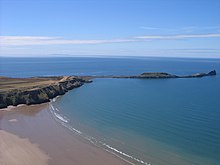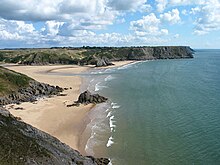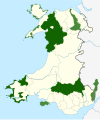Gower Peninsula
Gower Peninsula
| |
|---|---|
 Rhossilibeach | |
Location withinSwansea | |
| Population | 76,400 |
| OS grid reference | SS465904 |
| Principal area | |
| Preserved county | |
| Country | Wales |
| Sovereign state | United Kingdom |
| Postcode district | Swansea |
| Police | South Wales |
| Fire | Mid and West Wales |
| Ambulance | Welsh |
| UK Parliament | |
| Senedd Cymru – Welsh Parliament | |
| Gower |
|---|
 |
Gower(Welsh:Gŵyr) or theGower Peninsula(Penrhyn Gŵyr) is inSouth West Walesand is the most westerly part of the historic county ofGlamorgan,Wales.It projects towards theBristol Channel.In 1956, the majority of Gower became the first area in theUnited Kingdomto be designated anArea of Outstanding Natural Beauty.
Until 1974, Gower was administered as arural district.It was then merged with thecounty boroughofSwansea.From 1974 to 1996, it formed theSwansea district.[1]Since 1996, Gower has been administered as part of the unitary authority of theCity and County of Swansea.
Since its establishment in 1999, theGower Senedd constituencyhas only elected Labour members. TheGower constituency in Westminsterhad previously also elected only LabourMembers of Parliament(MPs) since 1908; the longest run (withNormantonandMakerfield) of any UK constituency. This ended in 2015 when theConservativestook the seat. In 2017, it returned to Labour. The area of both constituencies covers the peninsula and the outer Gower areas ofClydach,Gowerton,Gorseinon,Felindre,Garnswlltand encompasses the area of the historicLordship of Gowerapart from the city of Swansea.
Geography
[edit]
causeway exposed at low tide
About 70 square miles (180 km2) in area, Gower is known for itscoastline,popular withwalkersand outdoor enthusiasts, especially surfers. Gower has many caves, includingPaviland Caveand Minchin Hole Cave. Thepeninsulais bounded by theLoughor Estuaryto the north andSwansea Bayto the east. GowerArea of Outstanding Natural Beautycovers 188 km2,including most of the peninsula west ofCrofty,Three Crosses,Upper Killay,BlackpillandBishopston.[2]The highest point of Gower is The Beacon at Rhossili Down at 193 metres (633 ft) overlooking Rhossili Bay.[3]Pwll Du and the Bishopton Valley form a statutoryLocal Nature Reserve.[4]
The southern coast consists of a series of small, rocky or sandy bays, such asLanglandandThree Cliffs,and larger beaches such asPort Eynon,RhossiliandOxwich Bay.The north of the peninsula has fewer beaches, and is home to thecockle-beds ofPenclawdd.
The northern coast is mainlysalt marsh,and is used for raising Gower salt marsh lamb which was registered as a Protected Designation of Origin in 2021 under UK law[5][6]and in 2023 under EU law.[7]
The interior is mainly farmland andcommon land.The population mainly resides in smallvillages and communitieswith somesuburbandevelopment in eastern Gower; part of theSwansea Urban Area.[8]
History
[edit]Stone Age
[edit]Wales is known to have been inhabited since at least theUpper Paleolithicperiod, and the Gower Peninsula has been the scene of several important archaeological discoveries. In 1823, archaeologists discovered a fairly complete Upper Paleolithic human male skeleton in Paviland Cave. They named their find theRed Lady of Pavilandbecause the skeleton is dyed inred ochre,though later investigators determined it was actually a male. This was the first humanfossilto have been found anywhere in the world, and is still the oldest ceremonial burial anywhere inWestern Europe.The most recent re-calibratedradiocarbon datingin 2009 indicates that the skeleton can be dated to around 33,000Before Present(BP). In 1937 theParc Cwm long cairnwas identified as aSevern-Cotswoldtype ofchambered long barrow.Also known as Parc le Breos burial chamber, it is a partly restoredNeolithicchambered tomb.Themegalithicburial chamber, or "cromlech",was built around 6,000 BP. In the 1950s, members ofCambridge Universityexcavating in a cave on the peninsula found 300–400 pieces offlintrelated to toolmaking, and dated it to between 14,000 and 12,000 BC. In 2010, an instructor fromBristol UniversityexploringCathole Cavediscovered a rock drawing of a red deer from the same period. This may be the oldestcave artfound inGreat Britain.[9]
Bronze Age
[edit]
Gower is also home tomenhirsor standing stones from theBronze Age.Of the nine stones[when?],eight remain today. One of the most notable of the stones is Arthur's stone nearCefn Bryn.Its 25-ton capstone was most likely a glacial erratic (a piece of rock/conglomerate carried by glacial ice some distance from the rock outcrop from which it came): the builders dug under it and supported it with upright stones to create a burial chamber. The remains of Sweyne Howes on Rhossili Down, Penmaen Burrows Tomb (Pen-y-Crug) and Nicholaston Long Cairn are three other well-known Neolithic chambered tombs. During the Bronze Age, people continued to use local caves for shelter and for burying their dead. Bronze Age evidence, such as funeral urns, pottery and human remains, has been found inTooth Caveat Llethryd,Culver Hole(Port Eynon) andCathole Cave.With the transition into the Iron Age, hill forts (timber fortifications on hill tops and coastal promontories) and earthworks began to appear. The largest example of this type of Iron Age settlement in the Gower Peninsula isCilifor Topnear Llanrhidian.
Roman era
[edit]
Roman occupation brought new settlement. The Romans builtLeucarum,a rectangular or trapezoidal fort at the mouth of theRiver Loughor,in the late 1st century AD to house a regiment of Roman auxiliary troops. Its remains are located beneath the town ofLoughor.Stone defences were added to the earthen ditch and rampart by AD 110 and the fort was occupied until the middle or end of that century. However, it was later abandoned for a time and in the early 3rd century the ditch naturally silted up. It appears to have been brought back into use during the reign ofCarausiuswho was worried about Irish raids, but was abandoned again before the 4th century. A Norman castle was later built on the site.
Anglicisation
[edit]Following theNorman invasion of Walesthecommoteof Gŵyr passed into the hands of English-speaking barons, and its southern part soon becameAnglicised.In 1203King John(1199–1216) granted theLordship of GowertoWilliam III de Braose(died 1211) for theserviceof oneknight's fee.[10]It remained with theBraose familyuntil the death ofWilliam de Braose, 2nd Baron Braosein 1326, when it passed from the family to the husband of one of his two daughters and co-heiresses, Aline and Joan. In 1215 a local lord,Rhys GrygofDeheubarth,claimed control of the peninsula, but in 1220 he ceded control to the Anglo-Norman lords, perhaps on the orders of his overlord,Llywelyn ap Iorwerth.
As an Anglo-Norman peninsula isolated from its Welsh hinterland but with coastal links to other parts of south Wales and southwest England, it developed its ownGower dialectof English.
Glamorgan
[edit]
In 1535, theAct of Unionresulted in theLordship of Gowerbecoming part of thehistoric countyofGlamorganwith the southwest part becoming thehundredofSwansea.
Present day
[edit]Agriculture remains important to the area with tourism playing an ever-increasing role in the local economy. The peninsula has a Championship statusgolf courseat Fairwood Park just off Fairwood Common, which twice hosted the Welsh PGA Championships in the 1990s. Meanwhile, the Gower Golf Club at Three Crosses hosts the West Wales Open, a two-day tournament on Wales'professional golf tour,the Dragon Tour. Gower is part of the Swanseatravel to work area.[11]
Landmarks
[edit]There are six castles on the Gower Peninsula:LandimoreCastle—also known as Bovehill Castle—Oystermouth Castle,Oxwich Castle,PennardCastle,Penrice Castle,Weobley Castleand numerous cairns and standing stones.
Four beaches haveBlue Flag beachand Seaside (2006) awards for their high standards:Bracelet Bay,Caswell Bay,Langland BayandPort Eynon Bay.[12][13]Five other beaches have been given theGreen Coast Award2005 for "natural, unspoiled environment":Rhossili Bay,Mewslade Bay,Tor Bay,Pwll Du Bay,andLimeslade Bay.[14]
Other beaches:
Llethryd Tooth Cave
[edit]The Llethryd Tooth Cave, or Tooth Hole cave, is aBronze Ageossuarysite in a limestone cave, about 1,500 yards (1.4 km) north north west of theParc Cwm long cairncromlech, on private land along the Parc Cwm valley, near the village of Llethryd. In 1961 the cave was rediscovered bycavers,who found human bones. An excavation was carried out by D.P. Webley & J. Harvey in 1962 revealing the disarticulated remains (i.e. not complete skeletons) of six adults and two children, dated to the Early Bronze Age orBeaker culture.Other finds are now held at theNational Museum of Wales,Cardiff:Early Bronze Age, or Beaker, collared urn pottery; flaked knives; a scraper; flint flakes; a bone spatula; a needle & bead; and animal bones – the remains of domesticated animals, cat and dog. ArchaeologistsAlasdair Whittleand Michael Wysocki note that this period of occupation may be "significant", with respect to Parc Cwm long cairn, as it is "broadly contemporary with the secondary use of the tomb". In their article published in The Proceedings of thePrehistoric Society(vol.64 (1998), pp. 139–82) Whittle and Wysocki suggest corpses may have been placed in caves near the cromlech until they decomposed, when the bones were moved to the tomb – a process known asexcarnation.[15][16][17][18][19]
At 1,525 m long (nearly 1 mile), the Tooth Cave is the longest cave in Gower. It has tight and flooded sections, and so is kept locked for safety.[20][21]
Representation in the media
[edit]- Mumblesset the scene for a six-part dramaEnnals Pointfeaturing Welsh actorPhilip Madoc.The series focused on the local lifeboat crew (1982)
- TheSusan HowatchnovelThe Wheel of Fortuneis primarily set in and near the Gower Peninsula, which plays an important part in the plot of the novel (1984)
- The film,Gower Boy,by artistGee Vaucherand musicianHuw Warren—a gentle, contemplative exploration of the Gower Peninsula in Wales—debuted at the 14thRaindance Film Festival(2006)[22]
- Rhossili and Worm's Headfeature in theDoctor WhoepisodeNew Earth(2006)[23]
- Rhossili Baybeach has been a location for theLloyds Banking Groupadverts featuring the iconic black horse galloping along the miles of sandy beach.[24][25][26]
- A fictional village in 1918, near The Worm's Head, is the location of aCharles Toddatmospheric mystery novel, "A Forgotten Place" (2018)
See also
[edit]- Gower (electoral ward)
- Gower (UK Parliament constituency)
- Gower dialect
- List of villages in Gower
- Cuisine of Gower
References
[edit]- ^"Archives Network Wales".Archived fromthe originalon 30 June 2009.Retrieved27 February2008.
- ^"The City and County of Swansea"(PDF).Archived fromthe original(PDF)on 26 March 2009.
- ^"Rhossili Bay".Enjoy Gower.Retrieved25 January2019.
- ^"Pwll Du and Bishopton Local Nature Reserve".Green Map.Retrieved8 December2010.
- ^"Gower salt marsh lamb receives protected status".BBC News. 11 August 2021.Retrieved11 August2021.
- ^"Welsh Gower Salt Marsh Lamb first new registration under new UK Geographical Indication schemes".Department for Environment, Food & Rural Affairs. 11 August 2021.
The meat gains its unique characteristics from specific vegetation and environment of the salt marshes on the north Gower coastline, where the lambs graze over long distances for more than half of their lifetime.
- ^"Commission Implementing Regulation (EU) 2023/1547 of 26 July 2023 entering a name in the register of protected designations of origin and protected geographical indications ('Gower Salt Marsh Lamb' (PDO))".European Commission.27 July 2023.Retrieved29 July2023.
- ^Gower (2008). In Encyclopædia Britannica. Retrieved July 22, 2008, from Encyclopædia Britannica Online
- ^"Carving found in Gower cave could be oldest rock art".BBC News.25 July 2011.Retrieved28 July2011.
- ^Sanders, I.J., Feudal Military Service in England, Oxford, 1956, p.12, note 1; Charter transcribed inClarke, G.T.,Cartae,vol.3, pp.234–5
- ^"National Statistics Online"(PDF).Archived fromthe original(PDF)on 10 October 2008.Retrieved11 February2008.
- ^"Keep Wales Tidy – Tourism – Blue Flags".Archived fromthe originalon 2 November 2006.
- ^"Keep Wales Tidy – Tourism – Seaside Award Beaches 2006".Archived fromthe originalon 14 September 2007.
- ^"Keep Wales Tidy – Tourism – Green Coast Award Beaches 2005".Archived fromthe originalon 6 October 2007.
- ^"Key Sites Southeast Wales – Neolithic and earlier Bronze Age"(PDF).Research Framework for the Archaeology of Wales website.Research Framework for the Archaeology of Wales. 22 December 2003.Retrieved4 November2008.
- ^"Tooth Cave (305613)".Coflein.RCAHMW.11 July 2002.Retrieved4 November2008.
- ^"Bibliography of Cave Sites Literature".Chamberlain, A.T. & Williams, J.P. 2000 A Gazetteer of Welsh Caves, Fissures and Rock Shelters Containing Human Remains.Department of Archaeology and Prehistory, University of Sheffield. 5 December 2000. Archived fromthe originalon 9 June 2010.Retrieved4 November2008.
- ^"Bibliography of Cave Sites Literature".Chamberlain, A.T. & Williams, J.P. 2000 A Gazetteer of Welsh Caves, Fissures and Rock Shelters Containing Human Remains.Department of Archaeology and Prehistory, University of Sheffield. 5 December 2000. Archived fromthe originalon 4 May 2006.Retrieved4 November2008.
- ^Whittle, Alasdair;Wysocki, Michael (1998)."Parc le Breos Cwm Transepted Long Cairn, Gower, West Glamorgan: Date, Contents, and Context".Proceedings of the Prehistoric Society.64.London:The Prehistoric Society:177.doi:10.1017/s0079497x00002206.ISSN0079-497X.
- ^"Tooth Cave".UK Caves database website.UK Caves database. 2008.Retrieved4 November2008.
- ^"Gower Caves".Explore Gower.Stella Elphick. 2008. Archived fromthe originalon 26 January 2019.Retrieved25 January2019.
- ^"Fourteenth Raindance Film Festival | 27.09.06 – 08.10.06".14 November 2006. Archived fromthe originalon 14 November 2006.
- ^"The Welsh Connection: 5 Factoids about the Doctor and Wales".BBC.1 March 2015.Retrieved1 March2015.
- ^"Twitter: Lloyds Bank".May 2021.Retrieved13 August2021.
- ^"Lloyds Bank Press Release"(PDF).8 April 2017.Retrieved13 August2021.
- ^Turner, Paul (7 April 2017)."Rhossili Bay hits the small screen in new campaign".WalesOnline.
Library
[edit]- Prehistoric Gower, The Early Archaeology of West Glamorgan,by J. G. Rutter, 1949 (published by Welsh Guides, York Street, Swansea)
- Gower,by Olive Phillips, 1956 (published by Robert Hale Limited, London)
- Gower Journey,by A. G. Thompson, c1960 (self published by the author, Principality Chambers, Swansea)
- Portrait of Gower,byWynford Vaughan Thomas,1976 (published by Robert Hale Limited, London) (ISBN0709155778)
- The Gower Coast: A Coastline Walk And Guide To The History, Legends, Shipwrecks & Rescues, Smuggling, Castles & Caves, Including The Story Of The Dollar Ship,by George Edmunds, 1979 (ISBN0906570018)
- The Gower Peninsula,by Lawrence Rich (for The National Trust) (ISBN9781843592754)
- The Story of Gower,by Wendy Hughes, 1996 (ISBN0863812171)
- Historic Gower,by Paul Davies, 1997 (ISBN0715407325)
- Gower: A Guide to Ancient and Historical Monuments on the Gower Peninsula,by Diane M. Williams forCadw:Welsh Historic Monuments, 1998 (ISBN1 85760 073 8)
- Images of Wales: Gower Peninsula,by David Gwynn, 2002 (ISBN075242615X)
- The People of Gower,by Derek Draisey, 2003 (ISBN0954654404)
- Gower Rogues,by Derek Draisey, 2006 (ISBN0954654439)
- Gower,by Jonathan Mullard (in The New Naturalist Library,HarperCollins) (ISBN0007160666)
- Gower in History: Myth, People, Landscape,byPaul Ferris,2009 (ISBN9780956233202)
- Gower,byNigel Jenkins& David Pearl, 2009 (ISBN9781848510524)
- Real Gower,by Nigel Jenkins, 2014 (ISBN9781781722190)
- Black Apples of Gower,byIain Sinclair,2015 (ISBN978-1-908213-45-7)



